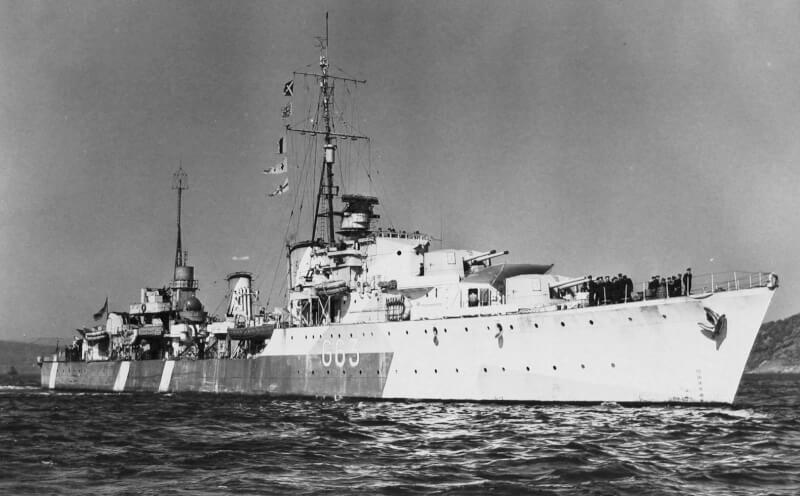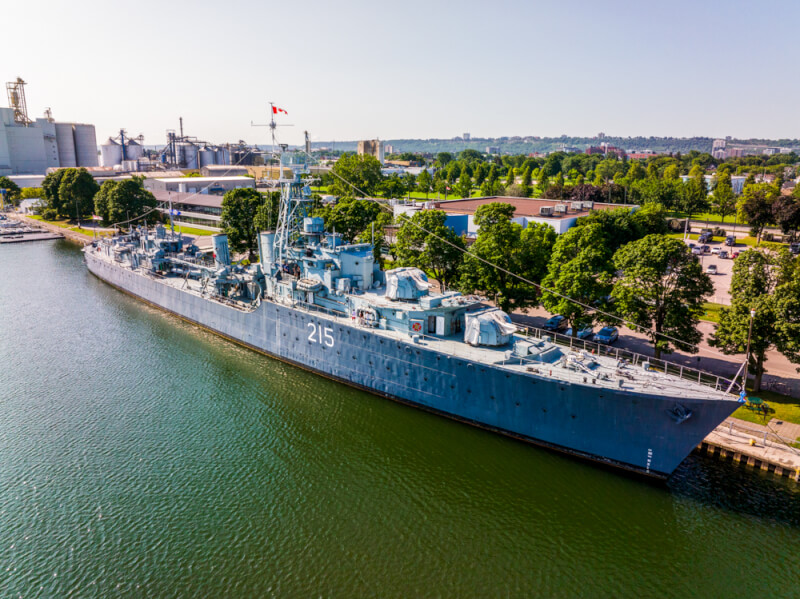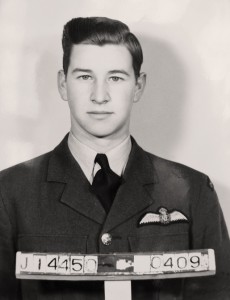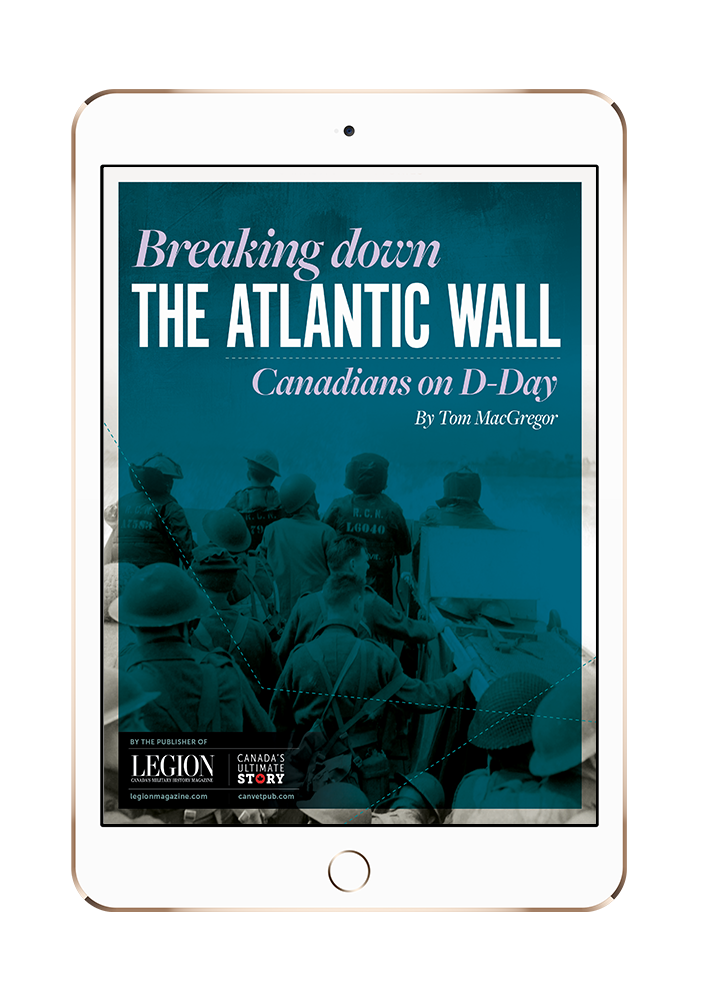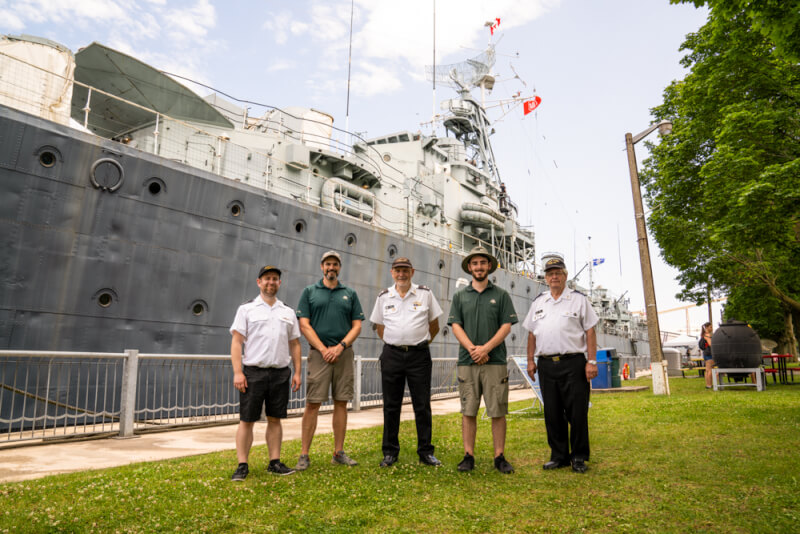
Jared Shawcross (second from right), with colleagues, is acting interpretation officer for HMCS Haida National Historic Site. [Parks Canada]
Dubbed Canada’s “fightingest ship,” HMCS Haida is the last Tribal-class destroyer found anywhere around the globe. Twenty-seven of its kind were constructed during the Second World War and they served with distinction. That service continued into the Korean War and broader Cold War.
Today, however, Haida’s primary purpose is for posterity, having been transformed into a national historic site in Hamilton Harbour, Ont., where it has inspired visitors since 2004. The museum ship’s acting interpretation officer, Jared Shawcross, spoke to Legion Magazine about the history, legacy, and his own deep admiration of HMCS Haida.
On HMCS Haida in WW II:
When HMCS Haida was commissioned [into the Royal Canadian Navy] in 1943, the first tour of duty it was assigned to was called the Murmansk run. This was a trip beginning in the north of Scotland and ending up at the port of Murmansk in the Soviet Union. It was an ice-free port year-round, meaning supply ships could transport war materiel that then supported Russia’s struggle on the Eastern Front.
The merchant vessels that brought the supplies needed protection when travelling through German-occupied waters off the Norwegian coast and through the Arctic Circle. HMCS Haida was one of the ships that did those treacherous escort duties.
Conditions were not great onboard, to say the least. Tribal-class destroyers were designed with an open bridge, meaning it’s not enclosed going through the Arctic Circle. We have great historic photos of massive ice buildup over the ship sides; you can imagine the sailors, not kitted out with winter gear, chipping away at it.
After spending time doing those Arctic convoys, HMCS Haida was transferred to the English Channel. There, the ship’s main duties were clearing the channel of U-boats and protecting [Allied] mine laying and minesweeping vessels in the region.
Most of the [German] vessels that HMCS Haida is credited with sinking occurred in either the English Channel or the Bay of Biscay, off the west coast of France. It also participated in preparations for the D-Day landings, ensuring there was safe passage for the Allied troops en route to those Normandy beaches.
The only known loss of life aboard HMCS Haida during its 20 years of [combat] service was in the Bay of Biscay, where it encountered a German convoy in which an exchange of fire occurred. During that exchange, one of the shells about to be loaded into a gun detonated, killing two crew members and injuring a few others.
Tragic though it was, it’s still quite impressive that you can count on one hand the number of crew members who ever lost their lives aboard HMCS Haida. While it was technically the result of enemy action in one sense, it wasn’t the direct result as it was actually caused by the failure of onboard equipment. And it’s one of the reasons HMCS Haida got the nickname Lucky Lady, among other sobriquets.
On Haida’s Korean War service
At the end of the Second World War, the ship was decommissioned and appeared to have a future as a training vessel until the Korean War broke out. The decision had to be made whether the RCN would construct new vessels or refit old ones. They chose the latter, so the veteran Tribal-class destroyers received an upgrade.
The biggest changes included switching out the foremast for a lattice mast. This allowed for the installation of new radar equipment along with modified guns. Its conversion from a destroyer to a destroyer-escort modernized the ship, making it more self-sufficient and putting it in a great position for train-busting operations.
The so-called train-busting club was essentially a competition among UN forces to see who could destroy the most trains. This meant trying to pick them off as they came in and out of coastal tunnels, where destroying the train engine and carriages got you entrance into the club, and every train after that—regardless of whether it was the engine or the carriages—would count as an additional “point.”

Crew of USS BUCK transfer four-inch ammunition to HMCS HAIDA during its patrol off the east coast of Korea on June 9, 1953. [Allan F. Jones/DND/LAC/ PA-138197]
HMCS Haida was fairly successful. If you visit the ship today, you’ll see on the ‘B’ [gun] mount that there are two-and-a-half trains painted on either side. On Haida’s first attempt to join the club, it destroyed the carriages, but the engine escaped through a tunnel. That got a half point and admittance into the train smashers club instead of its train busting version. A subsequent attempt claimed two trains in a 24-hour period—one where it struck the engine and carriages, and one where it got the carriages, but the engine again escaped.
Despite this, as it was already in the club by that stage, it got two full points.
HMCS Haida did two tours of duty in Korea, the second with the United Nations peacekeeping forces after the war’s end. It was later used as a training vessel and embarked on a Great Lakes tour before officially being decommissioned in 1963.
On the ship becoming a museum
The ship was destined to be scrapped along with all Tribal-class destroyers when it was saved by private citizens, many of whom were ex-naval officers or people with other strong connections. They struck a deal with the RCN to essentially purchase the ship at a reduced rate under the condition that it remain operational in case the RCN ever needed it back. Of course, after six decades, that’s not going to happen.
Haida was a museum ship for many years before we here at Parks Canada took on the mantle [in 2002]. Our mandate is to preserve, protect and present cultural and national heritage, of which Haida is truly, unquestionably a unique example.
I always find it interesting how both large and small it feels at the same time. The ship is 377 feet [115 metres] long, which is quite large compared to, say, what you might see at a yacht club, but then you walk through Haida’s interior and think about how small it really is, how those wartime crew members would have had close-knit relationships in those spaces, finding their own family far from home.
Keeping Haida afloat and sharing its history provides a rare opportunity to interact with these spaces where sailors lived, worked, and served. Our [country’s] naval history is not often covered as much as, say, the ground forces in Europe or the aircraft that flew over the continent. Here, however, we can tell that naval tale.
This abridged interview has been edited for brevity and clarity.
Advertisement










